7 Trends Shaping the Future of Telemedicine in Healthcare
Did you know that the global telehealth market size is projected to grow exponentially to USD 55.6 billion by 2025 from USD 25.4 billion in 2020, at a CAGR of 16.9% during the forecast period? You must be pleasantly shocked!
Well, growth in the telehealth market trends is mainly directed by various factors but one of the major factors is the rising population! During this time of the Covid-19 pandemic how can we forget that we need to expand our healthcare industry? The growing prevalence of chronic diseases and the shortage of medical services has led to a brighter future of telehealth by increasing the healthcare mobile app development services. Whatever symptoms you are now dealing with, your diagnosis is just a call away!
Telemedicine: The Future Of Healthcare
The market of telemedicine in healthcare industry has grown significantly over the past few years. Using telecommunications, it enables healthcare professionals to evaluate, diagnose and treat patients virtually. The telemedicine approach has evolved over the last decade to such an extent that today it is the most integral part of the American healthcare infrastructure. North America is known to be the largest telemedicine market globally and it is envisioned to reach 35 billion dollars by 2025, according to Statista.
The global healthcare market is projected to grow massively by 2026 and is estimated to be valued at over $175 billion. There are numerous factors that have contributed to the growth of the market including – increased traditional health care costs, funding for telemedicine, increase in digital health users and the evolution of mhealth in the healthcare institution.
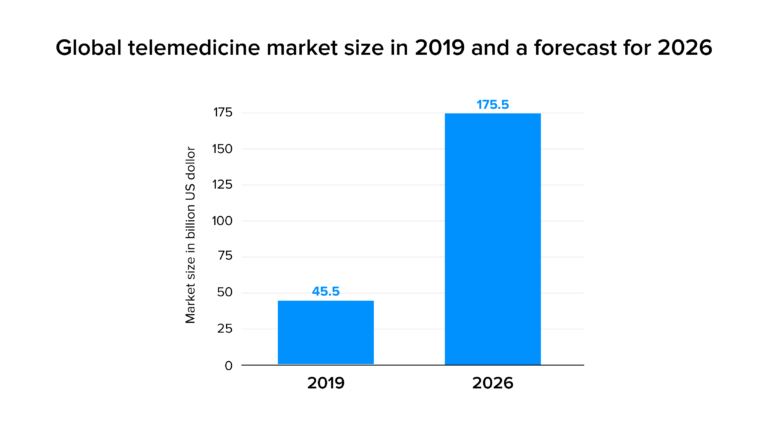
Two forms of telemedicine
- Synchronous Telemedicine: It requires the presence of both parties – patient and the healthcare professional at the same time in order to make a communication link that allows a real-time interaction.
- Asynchronous Telemedicine: It involves acquiring medical data and further transmitting the same data to a medical specialist at a convenient time for assessment offline.
Telemedicine trends, numbers you need to know
- More than 50% of all U.S. healthcare organizations provide a telemedicine program
- More than 50% healthcare organizations claimed that telemedicine improved the quality of patient care provided
- About 90% of the remaining healthcare organizations have already started working on a telemedicine program
- Around 55% of patients feel that telemedicine has increased their involvement in treatment decisions
Telemedicine Technology Amidst Coronavirus
The previous year was without a doubt one of the most eventful years for telehealth on the record. Covid-19 has changed the telemedicine future trends! Telemedicine adoption rate has significantly improved as you can see in the graph below.
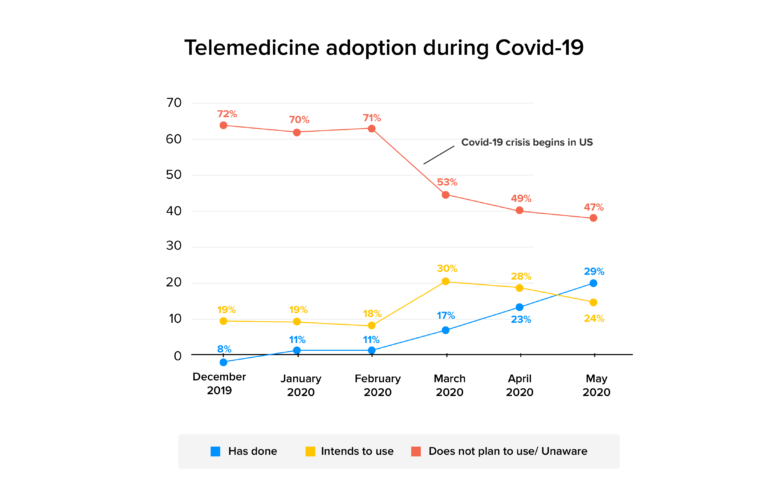
Also, in a survey done by Mckinsey, there was a drastic shift from 11% to 76% when it came to people who want to use telehealth.
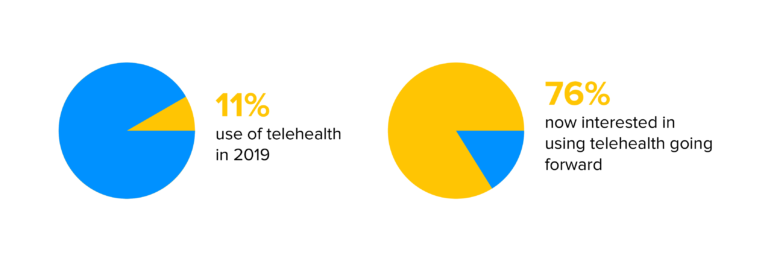
What Are The Future Trends Of Telemedicine?
The ‘digital first’ approach
Historically speaking, the healthcare industry has been a little slow when it comes to adapting the digital way of things. However, due to the coronavirus crisis the demands being placed on the healthcare ecosystem have accelerated! This has further resulted in the increase of investments in telehealth. Prior to coronavirus, Everest Group predicted healthcare providers will be increasing their spending on digital IT services by over 15% by the time we hit 2025. The firm has now changed its stance to higher investment and shorter time. It is safe to say that the era of digitalization is here!
The adoption of mhealth
mHealth is the new horizon for health through mobile technologies. In simple words, it is a specific way to utilize mobile technology to achieve improved health goals.The global mHealth market size was valued at USD 40.7 billion in 2019 – a number poised to keep increasing with time. Don’t you want to have a share of this revenue? The growing trend of preventive healthcare measures and the rise in funding or investments for mHealth start-ups also drive market growth.
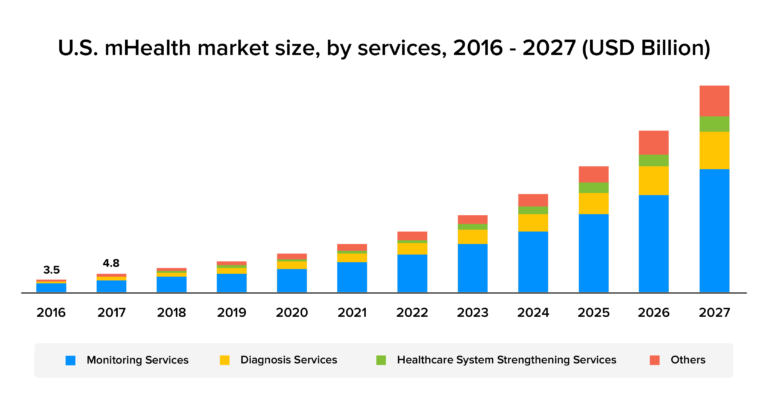
Artificial intelligence as a standard of care
During critical times, an AI-powered technology can be leveraged to provide automated interactions with patients during critical times. These AI based healthcare chatbots when integrated with medical information like symptoms, medications, treatments, doctors, conditions, etc can be a time savior. Not only this, AI applications can improve the speed and accuracy of the diagnosis process.
For example: FDA approved the first AI-based diagnostic device that is a system that looks into eye diagnosis by examining pictures of the retina. Once the high-quality photos are uploaded, the algorithm then starts to check for possible indications of diabetic retinopathy. The disorder was correctly identified by the software in 87% of the given cases, and it correctly identified individuals without the disease 90% of the time.
Technological shifts
The future of telemedicine trends in healthcare is impacted by many technologies. The major technology being 5G. It will provide a faster network speed that has the potential to completely transform the telemedicine ecosystem. This powerful network will be crucial for delivering medical images, remote patient monitoring, virtual meetings etc. Equipments, Medicines, and multiple other healthcare needs can also be determined by using real time technology. Other technologies such as – internet of medical things, blockchain and cloud technology are updating the telehealth world.
VR/AR applications and virtual visits
VR technology is helping both patients and doctors. From educating and training healthcare professionals to planning medical procedures, AR/VR seem promising!
Virtual visits make access to health care more convenient. People can see and talk to a medical professional through their smartphone, tablet or computer. Actual doctor visits are not necessary instead, they can visit with a doctor from the comfort of their own home. Virtual health applications have an increased investment provider as shown in the image below.
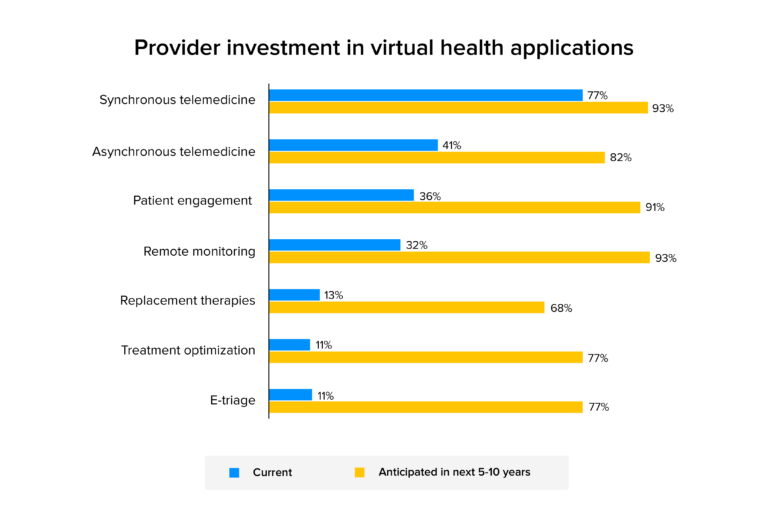
Remote medical services
The future of telemedicine technology has no limits! Many healthcare organizations are thinking of outsourcing their niche via telemedicine. Genres like psychiatry, dermatology, neurology and mental health demand for vendors. This will result in a rapidly expanding and competitive market.
Globalization
The telehealth market growth size has now increased globally! Telemedicine trends are now anticipated to become a major source of international trade. Global investments is constantly enhancing the telehealth industry trends. The potential revenue from telehealth services could have a significant effect on the worldwide economy!
What Are The Benefits Of Telehealth As A Technology Trend?
Benefits of Telehealth
- Easy access to the best healthcare services.
- Patients who are elderly or chronically ill do not have to take the risk of travelling for a consultation with a medical professional
- It allows doctors to examine patients anywhere, anytime and share the outcomes in real time.
- It also makes the remote patient monitoring (RPM) process easier for the medical professionals since they can check-in on the patient anytime they see fit.
- Lower healthcare cost since it cuts the hospital stay in cost and readmissions.
What Are The Pros And Cons Of Telehealth?
Pros
Convenience and Accessibility
According to Cisco Study, 74% of patients favor simple access to medical care services over in-person interactions with providers for an easy and convenient approach.
Telehealth eliminates the barriers of arranging the appointment first, then taking the day off from work and then going to the clinic for an initial consultation
Such access turns out to be significant during crises where time is luxury. In the event that you have a specialist that is only a video call away, you can transfer data rapidly and effectively.
Also, if a patient suffers from a chronic disease and can’t visit the clinic or hospital frequently, then telemedicine is very valuable for standard tests and subsequent meet-ups.
Time Savings
In-person arrangements require additional time than a virtual visit since they take additional time than the actual test. The Harvard Medical School led an investigation on how long patients spend time on medical visits.
They tracked down that a normal doctor visit consumes almost 121 minutes for patients. This averagely involves a normal of 37 minutes for travel, 64 minutes for form filling in waiting rooms, and 20 minutes with the doctor. Travel may take considerably more time and effort for those in rural regions or for the individuals who depend on public transportation.
Virtual visits through telecommunication utilize fundamentally less time. They don’t need travel time, and patients can round out structures online, before their virtual appointment. They additionally don’t have to invest a lot of energy and time waiting, yet they can likewise be useful during this stand by time from any place they are.
Easy Follow-Up
A few visits are just for follow-up. Regardless of whether it be for post-medical procedure or ailment, doctors may simply have to check in with patients to perceive how they’re doing. It’s a hassle to visit the doctors for these quick appointments, particularly for those recovering who need rest and can’t drive on their own.
With a virtual visit, patients can remain in the solace of their home for a quick follow-up evaluation. The doctors can ensure that their recovery is working out in a good way and decide if they need to return for more assessment.
Cons
Limited Scope
Virtual care is restricted to preliminary meetings and subsequent meet-ups. For example, a doctor can’t physically direct any checks on you during a virtual interview or consultation. While telehealth is sufficient for minor discussions, it can’t replace the need and unwavering quality of traditional in-person conferences.
There’s likewise the question of exactness. While a professional health expert can analyze a condition virtually for all intents and purposes, it’s frequently hard to evaluate the seriousness of it without actual assessment.
Requires Smart Devices
Not only does both the patient and doctor need an internet connection, however they also need devices that can uphold these services. A medical services practice will probably have access to these gadgets.
Requirement of a device also implies that unless a patient can bear the cost of a gadget or acquire one from somebody dependable, they essentially will not have any telehealth services access.
Requires Internet
The Internet is an important source here in telehealth, without which consultation is not possible. Despite the fact that some parts of conversation can be arranged over the call, most parts will require some visual evaluation from the doctor.
According to some research, 10% of Americans don’t use internet. These services additionally heavily depend on a decent online association that not every person has. Assuming either the patient or doctor loses connection, then the whole visit stops. This could stretch or even delay the appointment.
In The End
So if you want to invest in the most promising industry and need to hire a healthcare app development company in USA, your time is now! The current crisis has clearly demonstrated the relevance of telehealth industry trends and healthcare application development. The $3 billion worth market comes with the potential to grow up to around $250 billion. The seeds for success have already been sown, all you have to do is reap by trusting App inventive as a healthcare mobile app development company.

strategies your digital product..





